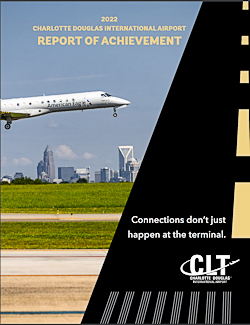We’ll Get There
 It has been a little more than a year since our industry hit a major bout of turbulence. I’m not sure how many of you would have predicted how things would look one year later, but there’s no doubt that we’ve changed.
It has been a little more than a year since our industry hit a major bout of turbulence. I’m not sure how many of you would have predicted how things would look one year later, but there’s no doubt that we’ve changed.
No, there wasn’t an apocalyptic crash of our airport system, or our economy, for that matter. On the other hand, passenger traffic and airport revenues have taken a substantial hit. As is typically the case, the take-home summary is not a simple black-or-white conclusion.
So, what are some takeaways from the past pandemic-filled year?
For starters, governmental funding made a pivotal difference. The CARES Act, supplemental AIP dollars and other relief payments were huge factors that are helping buoy U.S. airports. Not only did this money prop up payrolls and operations, it provided valuable funds for infrastructure projects. Conversely, Canadian airports, without federal aid, were left to fend for themselves; and reduced headcounts and operations were much more common.
On a related front, airport improvements continued at a terrific pace. Sure, some projects were delayed or scaled back. But overall, they are still happening at a rate needed to continue long-term industry growth. In fact, project rates follow the trends we’ve experienced over the last decade more than they reflect the realities of depressed passenger counts from 2020 and early 2021. Just look inside in this issue for examples. There is a plethora of stories about airports expanding their facilities and services to meet tomorrow’s growth, not stuck in pandemic-induced stagnation.
Lastly, we all “made do” with Zoom calls and virtual conferences while travel restrictions were in place, but they, too, will fade from prominence. Just as customers are eager to dine at restaurants rather than outside in tents outfitted with propane heaters, passengers will choose to fly for business and pleasure rather than settle for virtual communications. I, for one, can’t wait for that day.
-Paul
2022 Charlotte Douglas International Airport Report of Achievement
 Giving back to the community is central to what Charlotte Douglas International Airport and its operator, the City of Charlotte Aviation Department, is about, and last year was no different.
Giving back to the community is central to what Charlotte Douglas International Airport and its operator, the City of Charlotte Aviation Department, is about, and last year was no different.
Throughout 2022, while recovering from the COVID-19 pandemic, we continued our efforts to have a positive impact on the Charlotte community. Of particular note, we spent the year sharing stories of how Connections Don't Just Happen at the Terminal - from creating homeownership and employment opportunities to supporting economic growth through small-business development and offering outreach programs to help residents understand the Airport better.
This whitepaper highlights the construction projects, initiatives, programs and events that validate Charlotte Douglas as a premier airport.
Download the whitepaper: 2022 Charlotte Douglas International Airport Report of Achievement.
Recent Industry Insider columns
- A Bittersweet Goodbye
- Cyberattacks on the Aviation Sector: Threats, Trends and Strategies
- Empathy is Key to Effectively Working with the Media
- Carbon Capture, Utilization and Sequestration: An Environmental Gold Mine for Aviation?
- Now is the Time for Los Angeles to Lean Into its Aviation Legacy and Shape the Future








